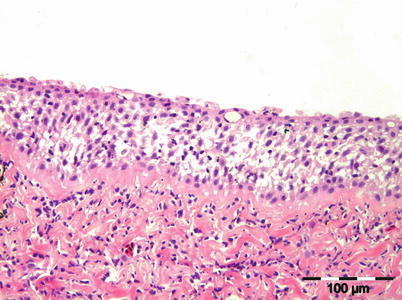, Patricia A. Noguera1 and Trygve T. Poppe2
(1)
Marine Scotland Science, Aberdeen, UK
(2)
Norwegian School of Veterinary Science, Oslo, Norway
Abstract
Diseases with uncertain or compound aetiology occur in fish farming and defined as those where the aetiology is unknown, or idiopathic. However, this may be difficult to ascertain and furthermore many different conditions may occur concurrently with more well-defined diseases, such as those with an infectious aetiology. It is characteristic for many idiopathic diseases that they may not be lethal themselves, but when they affect an immuno-compromised fish or occur with other agents, they may cause clinical disease and associated mortality. Similarly, the transition between production-related disease and infectious disease can be obscure.
Keywords
IdiopathicSalmonTroutAs with almost any farmed species, diseases with uncertain or compound aetiology also occur in fish farming and for the purpose of this book idiopathic diseases are those conditions where the aetiology is unknown. In some cases, these conditions are the result of different types of manipulations of the fish, the feed and the environmental factors in order to optimise the production and increase profitability. Due to the complexity, their aetiology may be difficult to ascertain and furthermore, many different conditions occur concurrently with more well-defined diseases, e.g. those of infectious aetiology. It is characteristic for many idiopathic diseases that they may not be lethal themselves, but when occurring together with other agents or in immunocompromised fish, they may cause clinical disease and mortality. For example, fish with shortened opercula, frayed fins or cardiac diseases, can cope with normal farming practices well, but are typically among the first to succumb during stressful events like crowding, treatments, suboptimal environment and outbreak of infectious diseases. The transition between production-related disease and infectious disease can also be obscure. Certain conditions such as skeletal malformations or metabolic disorders/dysfunctions are representatives of emerging or production disease and some examples of them (cardiac lesions, nutrition and deformities) are covered in other sections of this book. Selected idiopathic diseases are discussed below.
11.1 Ulcerative Dermal Necrosis
Losses in native Atlantic salmon and sea trout in Britain were the subject of investigation by an early fishery research project during the late 1800s and early 1900s. This work was carried out in Scotland into the so called ‘Salmon disease’, which is referred to as ulcerative dermal necrosis (UDN). Although many thousands of salmon died and the apparent spread between watersheds indicated an infectious cause, to date there has been no definitive agent identified. Furthermore, there are no records of UDN from farmed fish.
UDN is a chronic dermatological condition described from adult Atlantic salmon and brown trout returning to fresh water. Signs include small superficial grey-coloured head lesions above the eye, along the snout or adipose fin, often with erosion on the cranium, to deeper ulcers involving large areas principally on the top of the head (Figs. 11.1 and 11.2). In the latter stages, infection with Saprolegnia parasitica is frequently associated with the open wounds. In addition there are reports of UDN from wild brown trout (Fig. 11.3). Histologically the early, or pre-mycotic stage is limited to swelling and degeneration of melanophores below the basal layer, with acantholysis and pemphigoid-like degeneration mainly affecting the lower layers of the epidermis (Fig. 11.4). This is followed by a progressive cytolytic necrosis restricted to specific sites on the head, with foci of severe acantholysis. The pemphigoid bulla has been attributed to or linked to photosensitization. In more advanced lesions epidermal infiltration and/or necrosis, haemorrhage, dermal disarrangement, necrosis and infiltration can be observed (Fig. 11.5). The underlying skeletal muscle is not affected. In the final stage detachment or loss of the epidermal layer occurs and fungal hyphae are often detected but without any significant inflammatory response. Fish die from circulatory failure resulting from the osmotic haemodilution induced by wide areas of ulceration. The histological examination, together with the macroscopic characteristics of early skin lesions is considered pathognomonic for UDN, however, the presence of hyphae reduces the likelihood of a definitive diagnosis. In the absence of a clear aetiology and an agreed case definition for this condition, it is fair to highlight that other skin conditions may also present some or all of the histological features described.
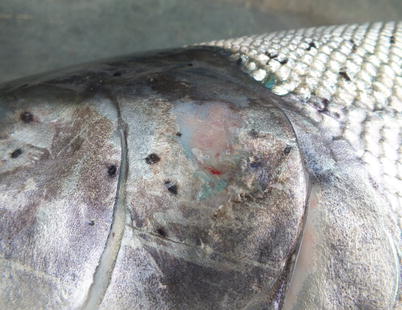
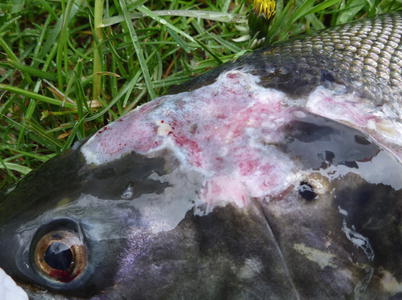
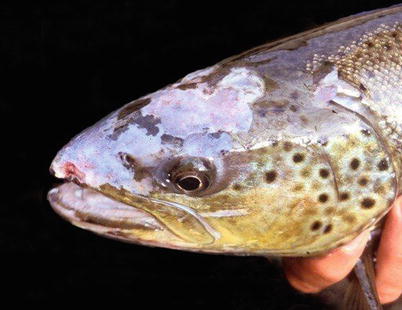
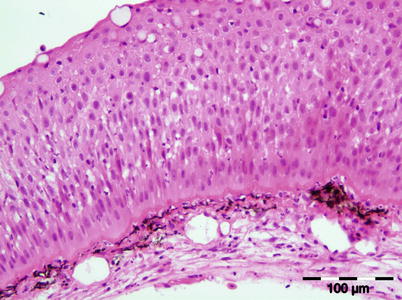

Fig. 11.1
Wild adult Atlantic salmon with early ulcerative dermal necrosis lesions on head

Fig. 11.2
Wild adult Atlantic salmon with moderate ulcerative dermal necrosis

Fig. 11.3
Wild brown trout with ulcerative dermal necrosis lesion

Fig. 11.4
Acantholysis and pemphigoid-like degeneration of the epidermis from Atlantic salmon with ulcerative dermal necrosis

